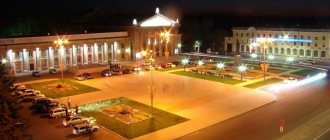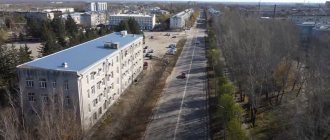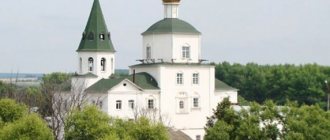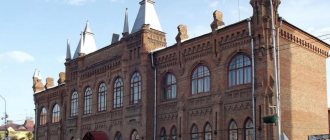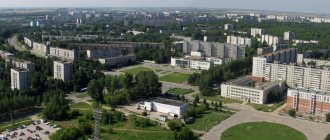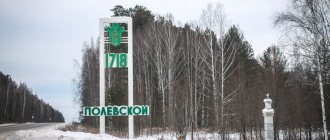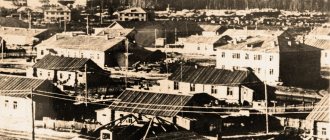Bogorodsk is a small town in the Nizhny Novgorod region, an administrative regional center. Its area is approximately 54.5 kilometers.
The satellite map of Bogorodsk shows that the outskirts of the city consist of several districts, separated from each other by the territories of the region.
- The city was founded in the 16th century as a trading village of Bogorodskoye.
- Bogorodsk developed thanks to crafts related to leather dressing.
- Bogorodsk received city status in 1923.
Today the city's population numbers more than 38 thousand inhabitants - it is one of the largest settlements in the Nizhny Novgorod region.
Pages of history
Bogorodsk is the city where you were born and live
Author: M. Smirnova, director of the museum
Bogorodsk is the city where you were born and live. Your parents and friends live here. Bogorodsk became a city on July 30, 1923, and before that it was a large trading village. A legend will tell you why our city is called that: “A merchant was traveling from the Nizhny Novgorod fair with rich goods, got lost in the local forests and lost his way. The day was approaching evening and it was getting dark. The merchant became afraid: at that time there were not only wild animals in the forests, but also robbers. The merchant got off his horse and began to pray to the Most Holy Theotokos for salvation.
Suddenly it seemed to the merchant that someone was looking at him from the bushes. He was not timid and boldly stepped towards his destiny, and... among the green foliage he discovered the icon of the Nativity of the Virgin Mary. He took this as a sign of his successful salvation. He took the newly-minted icon, mounted a horse, and he himself found his way through the forest thicket, led the merchant to the shore of a clean lake-key (later - Kabatsky). He drank water, watered his horse, looked around, saw peasant huts and a tavern on the shore and realized that he was saved. He gave the merchant his honest word that he would build a church on the shore of the lake as a sign of his successful salvation. And the merchant's word is true. After some time, axes began to knock here, and a church was erected on the shore of the lake, and an icon was placed in it. One hot summer day a thunderstorm broke out. Lightning struck the temple and a fire started. The entire population of what was then a large trading village came running to the fire, but no one dared to put it out - they considered it a punishment for their sins. The church burned to the ground, but the icon remained unharmed.
And the rumor spread that this icon was not simple, but miraculous. It was decided to build a new temple - a white stone one. In these places, rich in red clay, bricks were produced in abundance. The white rubble stone for the construction of the temple was transported from Kasimov along the Oka River, and then on carts from the Dudenevskaya pier.
The miracle temple soared like a white swan over the blue waters of the lake. The icon was sacredly revered by the village residents, and in its honor a great patronal feast was held, which fell on September 8 (21). At the same time, a large autumn fair was held, which was called the Mother of God. When going to the fair, peasants from distant places sometimes forgot the former name of the village of Podolets, and they used to say: let's go to the Mother of God, to Bogoroditskoye, to Bogorodskoye. This is how the new name was assigned to the village.
Every schoolchild knows this legend, and you should learn it so that you can tell about your city to those who come to our place for the first time. And be sure to tell us about how big and small residents love their Bogorodsk. Every year on City Day, according to tradition it is celebrated on the last Sunday of June, people gather on Red Square to tell what new has been built and done to make life in it even better and more comfortable, as well as to say words of love and gratitude: Every person has a date of birth. But no one can say for sure when the city arose, when people came to these places, who they were. It was too long ago, when people still did not have letters and chroniclers. Therefore, historians agreed: the first written mention in a chronicle source should be considered the birthday of cities. The village of Bogorodskoye was first mentioned in 1570 in connection with the resettlement of Veliky Novgorod residents to our area.
There is every reason to believe that people settled here much earlier. The settlement of the place began along the ravine, the valley through which a clear river flowed - these are the current streets of Bragin, Danilov, Sushnikova, 1st and 2nd Ryazanka.
The settlement was originally called “Podolets”, as a settlement located “along the valley” (ravine). The river also received the same name. At the end of the 18th and beginning of the 19th centuries, the river was called Bogoroditskaya. Leather production arose along this river. The river and the streams that feed it began to be blocked by earthen bridges. In enclosed areas, the skins were soaked and the skins and wool were washed. It was then that the river began to be called Ryazanka.
The status of a city was assigned to Bogorodsk by a decision of the All-Russian Central Executive Committee on July 30, 1923.
The worker Panteley Mikhailovich Furin was elected the first chairman of the city council. Dedicated to Bogorodsk
I was lucky to be born in this city, to live in this house where I now live. And with sincere tenderness and pride I speak about Bogorodsk in poetry. I look out the window and understand: There is no dearer street to me. I accept the city as it is, and its evening light is dear to me. I wish Bogorodsk prosperity, comfort, beauty and kindness. Let the people's wishes, cherished hopes and dreams come true. Semina Larisa BEREZOPOLYE Words by I. Mulikhina Music by A. Nikitin He stands on the plain, dressed in gardens, Poplars and birches are making noise everywhere. How beautiful Bogorodsk is both in winter and in summer, When the sun is hot or the blizzards are humming. CHORUS: Berezopole, you are my home, you are my garden, you are my land. I live here, and everything is dear to me without embellishment. I sing about you, I pray for you, our Bogorodskaya land. It is cozy and quiet, our city is not flashy, far from the river, but there are lakes all around. For those who were born and raised in Bogorodsk, every bush here is familiar and every house is dear. CHORUS. I see familiar faces on the streets. Tanners live here - good people. And let them leave, seek happiness in the capitals, But their souls are constantly registered here. CHORUS. Every year it grows and becomes more beautiful. New buildings around are crowding out fields. A small corner of our dear homeland, Bogorodskaya, a land close to our hearts. CHORUS. I've lived in this city all my life.
Bogorodsk on the map of Russia: geography, nature and climate
On the map of Russia, Bogorodsk can be found southwest of Nizhny Novgorod, 7 kilometers from the Oka on the banks of the Ryazanka River .
The city is located on the flat part of a swampy basin.
The eastern outskirts of the city are surrounded by ravines.
Bogorodsk is conventionally divided into two parts by a lake - the “ Kabatsky swamp ”.
The climate is temperate continental: cold winters, moderately warm summers, with moderate rainfall.
The lowest air temperatures are recorded in January, the warmest in July.
The Bogorodsky district is located in a zone of mixed forests with a predominance of deciduous trees.
Education and culture
History of education
The sprouts of public education in rural areas, including in the village of Bogorodskoye, appeared in the 30s of the 19th century.
The first school for teaching children in Gorbatovsky district was the Nativity parochial school. Since 1840 Voskresenskaya operates, and since 1858 Assumption schools, which were subordinate to the spiritual department. Subjects include church and civil literacy, arithmetic and “The Law of God.” At that time, the government was not interested in educating the general public. Only in 1862, after the abolition of serfdom, was the Alexander Men's School opened in the village of Bogorodskoye, and from 1846. Zemstvo schools operated with a course of study of three and then four years.
M.V. should be considered one of the first pioneers of school education in the region. Bravina is the daughter of a retired colonel who had a small estate in the village of Bannikovo. Having completed his education in 1863. in Nizhny and being influenced by populist views, she decided to devote herself to educational work among the peasants. For this purpose, she comes to her father’s estate in the village of Bannikovo and in his house opens a free school for peasant children. For 9 years M.V. Bravina taught hundreds of peasant children from five villages of the former Oleninskaya volost.
On the initiative of teachers at the Alexander Parish School in 1862. A Sunday school for adults was opened. But soon, by government decision, these schools were closed.
In the seventies and nineties of the XIX century in the village. Bogorodsky there was a youth cultural circle, and at the end of the 19th century an elementary tanning school was opened. Soon it was transformed into a school, on the basis of which in 1923. A tannery technical school was formed. Despite great difficulties and hardships, Bogorodskoye in these years became a true forge of tannery personnel.
Since 1899 The educational institution was headed by G.S. Kolynin, V.I. Gorbunov, D.Ya. Kozhurov, A.A. Pchelin, A.T. Luchinin, V.A. Lomakin, A.S. Bogatyrev. Many specialists graduated from the technical school, who later became major leaders, scientists, and public figures. Among them is Professor G.I. Kutyanin, Doctor of Sciences N.A. Mikhailov. Two graduates of the technical school during the Great Patriotic War, V.A. Shubin and N.K. Chechetko, became Heroes of the Soviet Union.
At the beginning of the 20th century, two-year schools were opened in Bogorodskoye, Shvarikha, Shargoly, Doskino, Oranki and Kamenki Nikolskiye. There were private schools in the villages of Bannikovo, Bogorodskoye, Kuznetsovo, Ubezhitsy, Shuklin and other villages.
The progress of the development of school education is indicated by the figures: if in 1863 there were 9 schools in the region, then by 1912 their number was 97, including 78 zemstvo schools. In 1912, 77.3% of school-age children were enrolled in education in the region. The Soviet government waged an active fight against illiteracy. For this purpose, temporary schools and literacy centers are being opened.
At the end of the 50s, new secondary schools were built in the city: seventh, sixth, first, the third floor of the third school was added. Students received large and bright classrooms, gyms, classrooms, and everything they needed for successful studies. Great changes in public education have also occurred in rural areas, where secondary school is a prerequisite for eliminating significant differences in the lives of urban and rural populations. In the post-war years, there were five secondary schools in the area - Doskinskaya, Kamenskaya, Dudenevskaya, Lakshinskaya and Khvoshchevskaya.
In 1962 When creating new state farms, the idea was laid down: “Every central estate of a collective farm-state farm has a secondary school.” Therefore, it was decided to build new secondary schools in the village of Gigant, village. Aleshkovo, Berezovka village, Novinki village, village. Komarovo, village Petrel. Over the years, Solonskaya, Shvarikhinskaya, Arapovskaya and Teryaevskaya incomplete schools were also built.
They built a lot, but at the same time, due to demographic changes, Shargolskaya, Bukinskaya and Burtsevskaya junior high schools were closed.
Boarding schools have been opened at Khvoshchevskaya and Kamenskaya secondary schools. In accordance with state standards, Shvarikhinskaya, Arapovskaya and Komarovskaya incomplete secondary schools are later transformed into secondary schools.
As a result, the school network of the city and region at the beginning of the 21st century. Compared to the second half of the 19th century, it has changed significantly: only in 1940. there were 110 schools, in 2003 - 28, including secondary schools - 17, junior high schools - 9, primary schools - 2; the number of students decreased from 17,008 (1940) to 6,840.
The Soviet school not only taught and gave children knowledge, but also carried out great educational work with both students and parents. The modern Russian school continues the best traditions of the Soviet school, instilling in children a love for their native land, for the Motherland, hard work, patriotism, a sense of friendship and other human qualities. For this purpose, extracurricular activities, labor and recreation camps, children's health camps, and military-patriotic education are used.
Teachers of the older generation and school directors did a lot for the development of the Bogorodsk school: the first city school - V.I. Gulyaniya, Dudenevskaya-A.P. Podkopaev, Khvoshchevskoy-D.A. Sakharovsky, Lakshinskoy-A.P. Tyurin, as well as the head teacher of the Doskin school E.I. Shaburov, director of orphanages: Alekseevsky-A.P. Orlova, city-F.A. Kubonina and many of their comrades.
The Bogorodsk school raised 12 honored teachers of the RSFSR and the Russian Federation and more than a hundred excellent students of public education in schools of the USSR, RSFSR and the Russian Federation and honorary workers of public education in schools of the Russian Federation.
An article from the schoolchild’s electronic encyclopedia “Berezopole: from A to Z”
Educational institutions today
As of January 1, 2010, there are 56 local municipalities operating in the region, of which:
- secondary schools – 25;
- primary school - kindergarten - 1;
- preschool educational institutions – 24;
- institutions of additional education for children – 3;
- education center – 1;
- special (correctional) general education school of the VIII type – 1;
- interschool training center – 1.
All educational institutions are legal entities, have licenses to carry out educational activities for all educational programs being implemented, have passed and have certificates of state accreditation in a timely manner.
In connection with the decrease in the number of school-age children in the 2008-2009 school year, the administration of the Bogorodsky district decided to liquidate the municipal educational institution No. 2 and change the status (type) of the municipal educational institution Arapovskaya secondary school to a general public school and the Klyuchishchinskaya secondary school to a general public school. Documents for liquidation and reorganization procedures are drawn up in accordance with current legislation:
- an expert assessment of the consequences of making a decision on liquidation or reorganization for ensuring the livelihoods, education and upbringing of children was carried out and a corresponding document (expert opinion) was prepared;
- Meetings of parents of students and school staff were held.
All students at Municipal Educational Institution Secondary School No. 2 continue to receive basic general education at Municipal Educational Institution Secondary School No. 3.6 in accordance with the statements of their parents (legal representatives). Students of the Klyuchishchinskaya secondary school in grades 5-9 were transferred to the Khvoshchevskaya secondary school, transportation by school bus was organized for them
Routes on the map of Bogorodsk. Transport infrastructure
P125 “Ryazhsk – Kasimov – Murom – Nizhny Novgorod” passes through the city .
From the Bogorodsk bus station (Dudenevsky Lane, 10, at the intersection of Dudenevsky Lane and Vokzalnaya Street) buses depart to Nizhny Novgorod and suburban settlements.
Within the city, the main form of public transport is buses.
Freight transportation is also carried out by water along the Oka River through the Dudenevo pier (7 kilometers from Bogorodsk).
From the Kozhevennoye railway station, located near Bogorodsk, only suburban services are provided. To travel to another city you need to make a transfer in Nizhny Novgorod.
Population
| Population | |||||||||
| 1897 | 1926 | 1931 | 1939 | 1959 | 1967 | 1970 | 1979 | 1989 | 1992 |
| 12 300 | ↗14 900 | ↗16 000 | ↗21 400 | ↗29 950 | ↗36 000 | ↗36 517 | ↗37 355 | ↗38 401 | ↘38 000 |
| 1996 | 1998 | 1999 | 2000 | 2001 | 2002 | 2003 | 2005 | 2006 | 2007 |
| ↘37 500 | ↘37 200 | ↘37 100 | ↘36 900 | ↘36 700 | ↗37 095 | ↗37 100 | ↘36 800 | ↘36 600 | ↘36 400 |
| 2008 | 2009 | 2010 | 2011 | 2012 | 2013 | 2014 | 2015 | 2016 | 2017 |
| ↘36 372 | ↘36 219 | ↘35 499 | ↘35 439 | ↘35 286 | ↘35 063 | ↘35 018 | ↘34 676 | ↘34 597 | ↘34 388 |
| 2018 | 2019 | ||||||||
| ↘34 240 | ↘33 931 | ||||||||
As of January 1, 2022, the city ranked 458th out of 1,115 cities in the Russian Federation in terms of population.
Notable natives
- Solonitsyn, Anatoly Alekseevich (1934-1982) - Soviet theater and film actor, Honored Artist of the RSFSR.
- Pozdeev, Anatoly Dmitrievich (1929-1998) - Soviet and Russian scientist.
